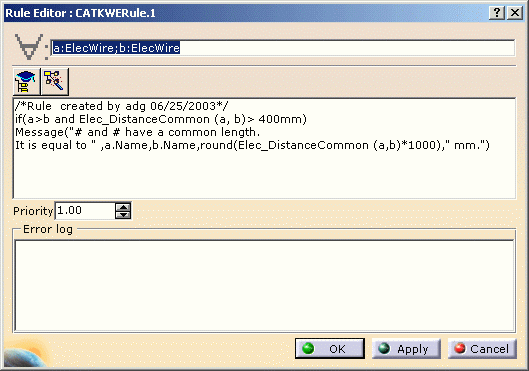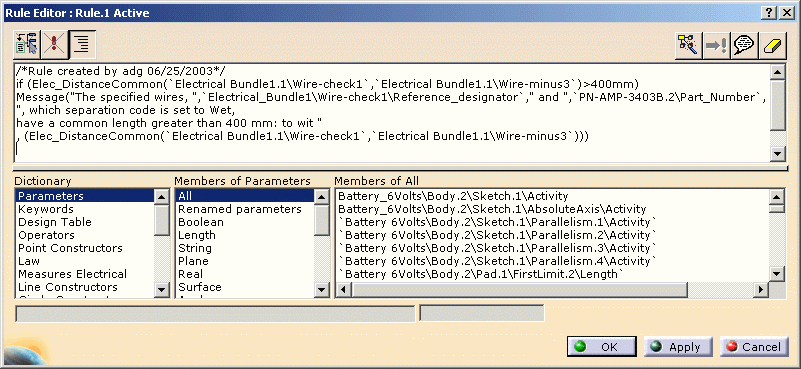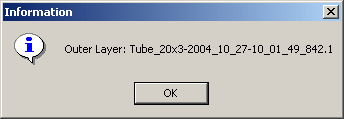|
Applying the rule displays the following message if the
condition is met: |
 |
Example 3
|
|
Still in Knowledge Advisor, to verify that two wires
selected in the specification tree have a common length, the following
action can be defined: |
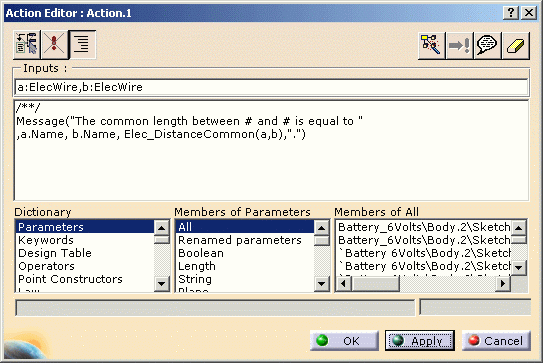 |
|
then select two wires in the specification tree and
click OK to validate. |
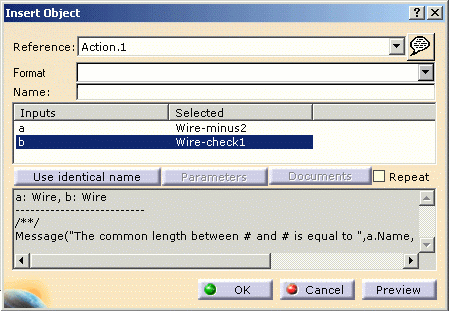 |
|
The following message displays: |

|
|
 |
DistanceWireProduct
|
Syntax
|
|
DistanceWireProduct(Wire1: Wire,
Object: Product):Length
Returns the minimum length between a wire and a product in session. The
product must contain at least one part. |
Example 1
|
|
The DistanceWireProduct user function can be
used with the f(x) command to display the distance between a wire and a
component in the session. |
 |
|
This formula returns the following value: |
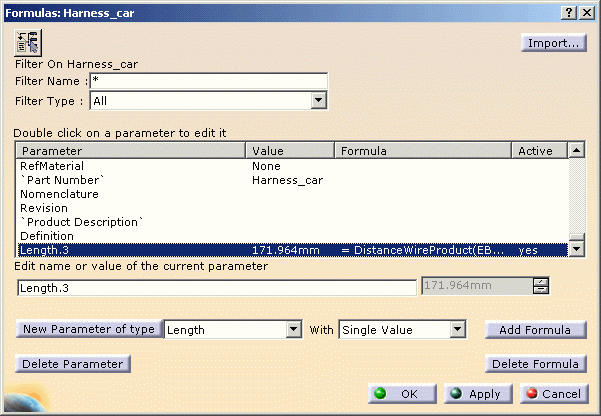 |
Example 2
|
|
The DistanceWireProduct user function can be
used in Knowledge Expert to find all the wires in the session that have a
minimum distance to defined components smaller than a critical value chosen
by the user. The components can be defined as heat-resistant.
Properties have been added to the product: |
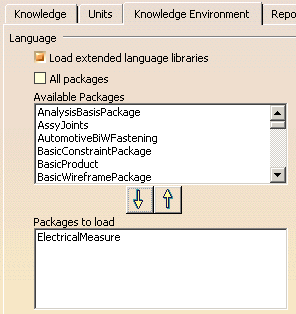 |
|
and to the wires: |
 |
|
A check is defined as follows: |
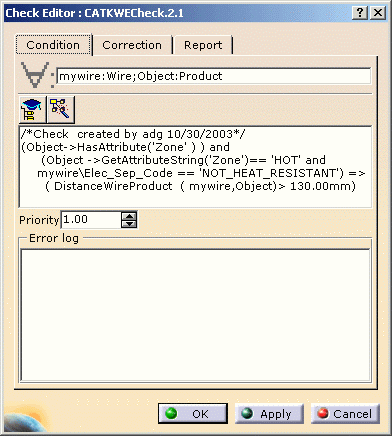 |
|
Updating the session displays green/red light on the check:

A report is generated showing the check result: some wires verify the
condition, while others do not. |
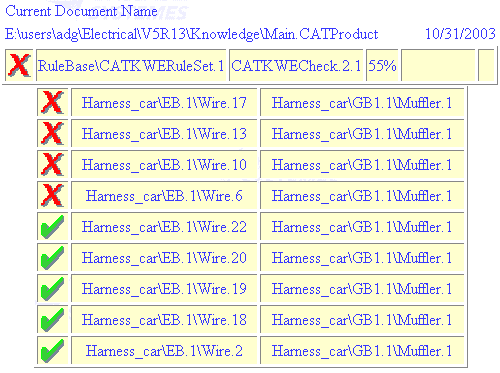 |
Example 3
|
|
The DistanceWireProduct user function can be
used in Knowledge Advisor to define a rule that displays a warning message
if a minimum distance between a wire and an object is smaller than a
critical value chosen by the user. |
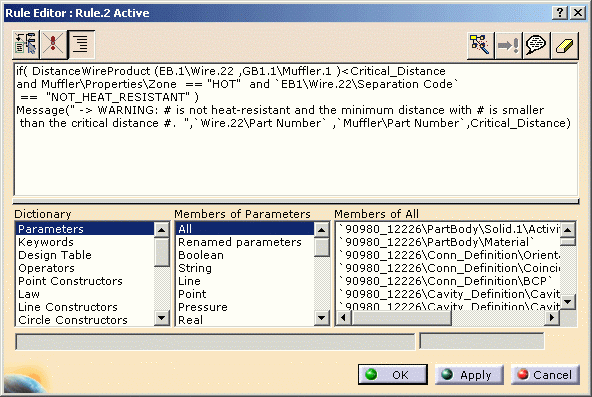 |
|
Running this rule displays the following message: |
 |
Example 4
|
|
Still in Knowledge Advisor, an action can be defined using
the DistanceWireProduct user function, to know the distance
between a wire and an object selected in the specification tree: |
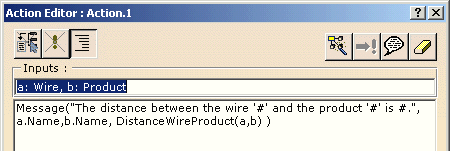 |
|
Run the action using the Action.1 contextual
menu:
select a wire and a product in the specification tree then validate. |
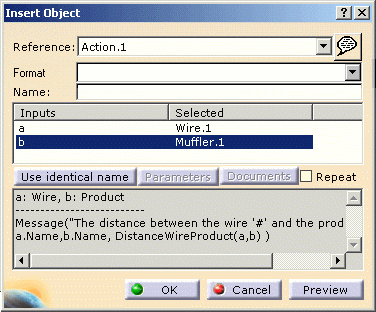 |
|
This message displays: |

|
|
 |
ListAllOuterLayerObjects
|
Syntax
ListAllOuterLayerObjects (ElecBundleSegmentExtremity:Feature,Offset:Real,ListOfAllCoveringProducts(Protections/Supports):out
List):Boolean
Returns an ordered list of protective coverings and supports that cover
the bundle segment at the point of interest.
The point of interest is defined by specifying from which end of the bundle
segment and entering an offset in mm. |
Example
A check (in KWE advanced language) to determine the protective coverings
and supports at 150 mm from end 1 (Extremity 1) of the bundle segment is
written as follows:
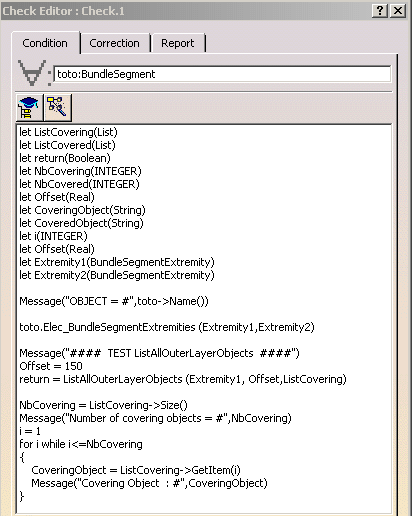
|
|
|
 |
ListDirectlyCoveredObjects
|
Syntax
ListDirectlyCoveredObjects((Protection/Support):Feature,
ListOfCoveredProducts(BundleSegments/Protections/Supports): out List):Boolean
Returns the list of bundle segments, protective coverings and/or
supports directly under the component (protective covering or support) you
want to analyze.
If the component you want to analyze is not a protective covering or a
support, the list returned will be empty. |
Example
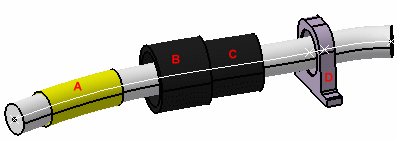
- Tape A is placed directly over the bundle segment
- Corrugated tubes B and C are linked to the bundle segment, and
corrugated tube B covers tube C
- Standard support D is linked to the bundle segment.
A check (in KWE advanced language) to determine the list of bundle
segments, protective coverings and supports under corrugated tube C is
written as follows:
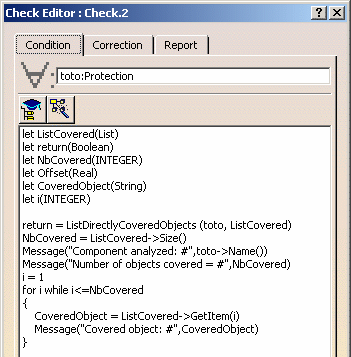
Running this check returns:
- The name of the component analyzed, in our case, corrugated tube C
- The number of objects covered by corrugated tube C:
- Followed by the name of this component: the bundle segment.
|
|
|
 |
ListDirectlyOuterLayerObjects
|
Syntax
ListDirectlyOuterLayerObjects ((BundleSegment/Protection/Support):Feature,
ListOfCoveringProducts(Protections/Supports): out List):Boolean
Returns the list of outer layers of protective coverings and/or supports
directly over the component (bundle segment, protective covering or
support) you want to analyze.
If the component you want to analyze is not a bundle segment, protective
covering or a support, the list returned will be empty. |
Example

- Tape A is placed directly over the bundle segment
- Corrugated tubes B and C are linked to the bundle segment, and
corrugated tube B covers tube C
- Standard support D is linked to the bundle segment
A check (in KWE advanced language) to determine the list of outer layers
that directly cover the bundle segment in the example is written as
follows:
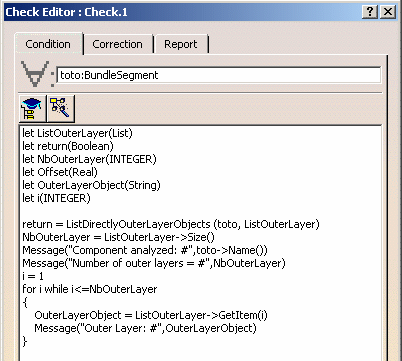
Running this check returns:
- The name of the component analyzed, in our case, the bundle segment.
- The number of outer layers over the bundle segment:
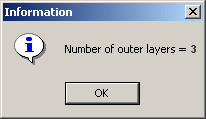 |
| Only 3 are found because corrugated tube B does not directly
cover the bundle segment since it covers corrugated tube C. |
- Followed by the names of these components:
|
|
|
 |
ListUsedSupports
|
Syntax
ListUsedSupports ((BundleSegment/BranchableBundleSegment):
Feature, ListOfSupports(Supports): out List): Boolean
Returns the list of supports through which a bundle segment or multi-branchable
document is routed. |
Example
|
| The example shows a multi-branchable document containing
two bundle segments, each routed through seven supports.
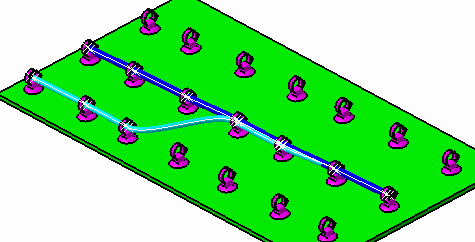
A rule (in KWE advanced language) to determine the number and names of
the supports through which each bundle segment is routed is written as
follows:
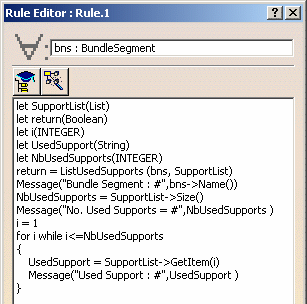
Solving this rule returns:
- The name of the bundle segment analyzed.
- The number of supports through which the bundle segment is routed.
- Followed by the names of these supports.
|
|
|
 |
 ListUsedSupportWithAbscissa ListUsedSupportWithAbscissa
|
Syntax
ListUsedSupportWithAbscissa (iBundleSegment:Bundle Segment,
oSupportList: List, oEntryPointAbscissa: List, oExitPointAbscissa: List): Boolean
Returns the list of supports in the order in which they are located
along the center curve of the bundle segment from the first extremity of
the said segment. Two other lists are output: entry point coordinates and exit point
coordinates of each support. |
Syntax
ListUsedSupportWithAbscissa (iBranchableBundle:Branchable
Bundle Segment, oSupportList: List, oEntryPointAbscissa: List,
oExitPointAbscissa: List): Boolean
Returns the list of supports in the order in which they are located
along the center curve of the branch from the first extremity of the said
segment. Two other lists are output: entry point coordinates and exit point
coordinates of each support. |
Example
An expert rule (created using Knowledge Expert) to determine the list of
all the supports located along all segments in the document that also
outputs support entry and exit point coordinates:
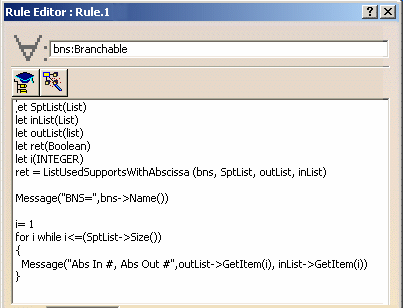
|
|
|
 |
VisualMode
|
Syntax
|
|
VisualMode (BundleSegment: Feature,
Visualization Mode (LIGHT/FULL): String): Boolean |
Description
|
|
This function is useful to minimize the size of the harness
in LIGHT mode. It simplifies the visualization, the curve and
the diameter only are represented, the rib being deleted.
This function is only available for bundle segments
belonging to multi-branchable documents. |
Example
|
|
Create a rule in Knowledge Expert:
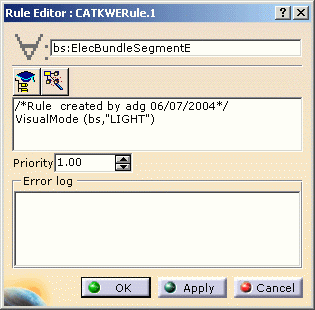
Running this rule displays the harness in LIGHT
mode:
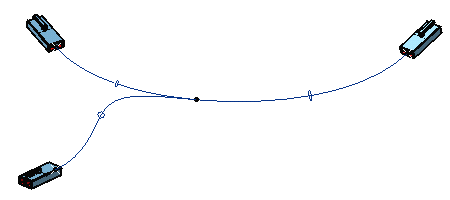
The rule is reversible: you can load a harness in
LIGHT mode and reload the geometry by applying the rule with the
FULL parameter:
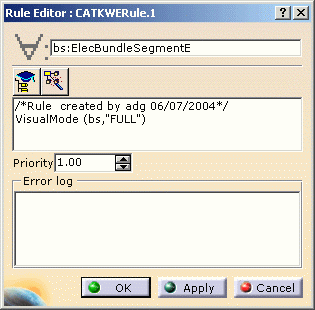
The harness is displayed in FULL mode: the rib is
recreated:

|
 |
Working in LIGHT mode allows you to modify the route and
route wires but the split, transfer and add branch point commands are not
supported.
To know more about these commands, refer to Electrical Harness Installation
- Working with Branches, Splitting Branches and Transferring Branches. |
|
 |
 ListIntSpliceWithAbscissa ListIntSpliceWithAbscissa
|
Syntax
ListIntSpliceWithAbscissa (iBundleSegment:Bundle Segment,
oIntSpliceList: List, oEntryPointAbscissa: List, oExitPointAbscissa: List): Boolean
Returns the list of internal splices in the order in which they are located
along the center curve of the bundle segment from the first extremity of
the said segment. Two other lists are output: entry point coordinates and exit point
coordinates of each internal splice. |
Syntax
ListIntSpliceWithAbscissa (iBranchableBundle:Branchable
Bundle Segment, oIntSpliceList: List, oEntryPointAbscissa: List,
oExitPointAbscissa: List): Boolean
Returns the list of internal splices in the order in which they are located
along the center curve of the branch from the first extremity of the said
segment. Two other lists are output: entry point coordinates and exit point
coordinates of each internal splice. |
|
 |
 InstantiateInternalProtection InstantiateInternalProtection
|
Syntax
InstantiateInternalProtection (iBundleSegmentExtremity:BundleSegmentExtremity,
ProtectionType:String, Length:Length, out oProtection:InternalProtection): Boolean
Instantiates a light protective covering from a segment extremity with a
given length.
The Protection type can be InternalTape (light tape protective
covering), InternalAdaptive (light adaptive protective covering),
InternalCorrugate (light corrugated tube) or InternalFixed (light fixed
diameter protective covering).
The protective covering is instantiated in the document containing
the segment extremity. |
|
 |

